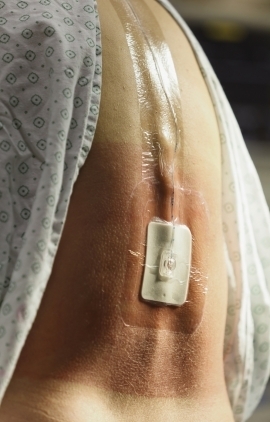Epidural anaesthesia

What is it?
What is it?To perform spinal anaesthesia or an epidural, the anaesthesiologist injects local anaesthetic around the nerves in the spinal cord. The nerves are responsible for transmitting pain signals to the brain. The administered medication blocks these pain signals.
The anaesthetised site
The part of the body that is numb depends on the site where the epidural is given.
- With a low epidural, you will not feel sensation in the bottom half of the body (often used for hip or knee replacement surgeries).
- An epidural placed at a higher level makes it so that you do not feel sensation in the abdominal area (often used for abdominal surgeries).
Pain pump
For some epidural cases, the anaesthesiologist leaves an 'epidural catheter' (a thin tube) in place. This catheter can be used to administer extra pain relief after the procedure. It may also be connected to an epidural pain pump so that you can be administered continuous anaesthesia.
Epidural anaesthesia for the birthing process or a caesarean section
Read more here about anaesthesia for the birthing process or a caesarean section.
Potential risks
Potential risksIn some circumstances, the anaesthesiologist cannot place an epidural:
- if you are allergic to local anaesthetic.
- if you have an infection at where the injection site would be (e.g. lower back).
- if you have already had a prior back surgery at the level of where the injection site would be.
- if you have a coagulation disorder or if you took blood thinners in the past few days.
Possible side effects
Possible side effectsThe epidural is a safe technique, but even so, it may have some side effects.
Blood pressure drop
This is why an IV is always placed before an epidural. A drop in blood pressure can be treated by giving extra fluids and, if needed, with medication that is administered intraveneously.
Reduced sensation in the legs (e.g. ‘fuzzy’ legs).
This is a normal effect of the medication that was administered. This is also why you are asked to stay in bed after the epidural injection.
Itching
This is also a side effect from the medication and is not dangerous. The itching will go away after the medication wears off.
Headache
Rarely, you may have a headache afterwards. This happens when a small hole was made accidentally in the spinal cord membrane. This is usually temporary and treated with a period of bedrest where you lie flat in bed. In exceptional cases, a ‘blood patch’ may be necessary. This requires that a new epidural be placed and that a small amount of blood be injected at that site in order to close the hole. That will almost always result in an immediate improvement in the symptoms.
Persistent nerve pain or paralysis
Persistent nerve pain or paralysis are extremely rare complications.
Centres and specialist areas
Centres and specialist areas
Latest publication date: 11/01/2024
Supervising author: Dr Vanoverschelde Henk



